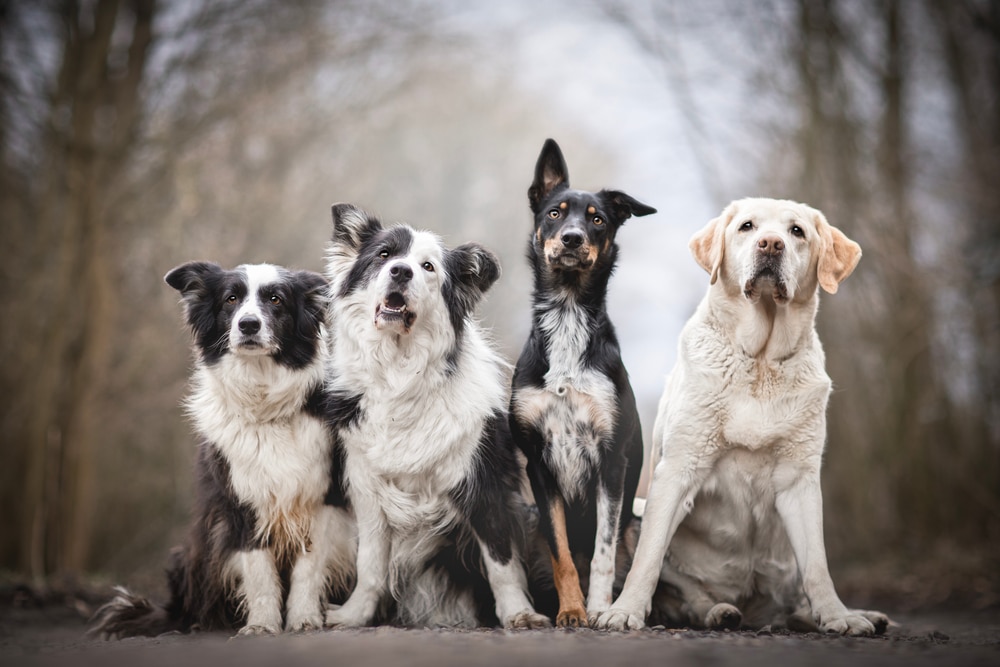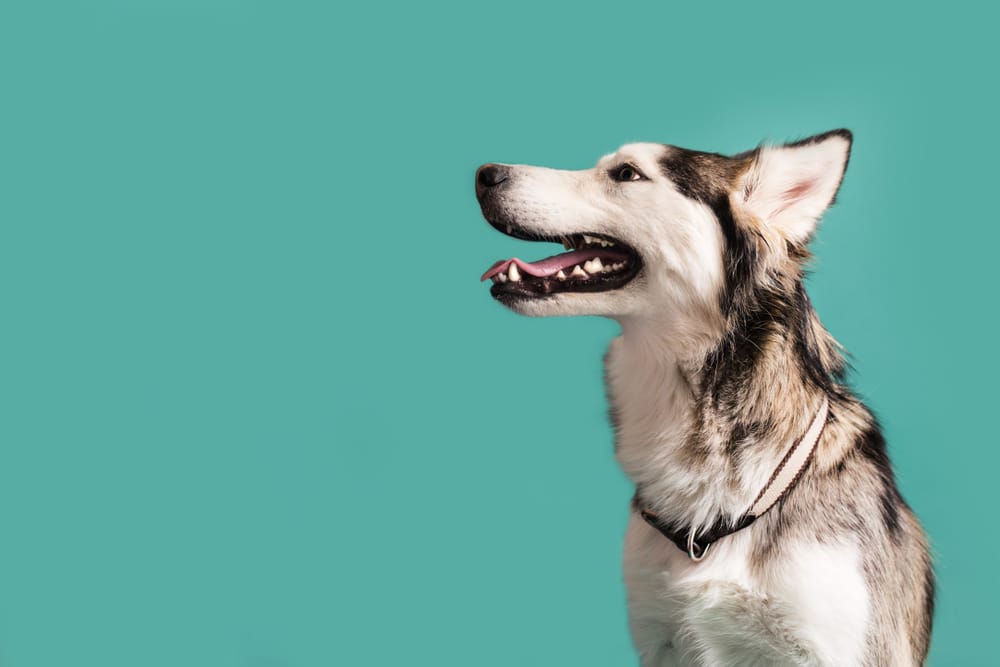Dogs are social animals and have social hierarchies among them. They have to compete within the group or pack for resources and establish dominance for maintaining order. However, bonds between humans and dogs is based on the fact that dogs consider us as their providers. So, does that make us the alpha too? Do dogs view us as the alpha?
Dogs do not view us as the alpha. A dog’s relationship with humans is not that of a typical pack member. In a pack, there is one alpha, which is considered the dominant member. Because humans are resource providers for dogs, dogs don’t consider us a competitor but instead a provider and a leader.
Table of Contents
- Evolution Of Dogs As A Pack Animal
- Understanding Social Hierarchy In Dogs
- What Is Dominance Theory?
- How Is A Wolf Pack Different From A Dog Pack?
- How Do Dogs Perceive Us In A Pack?
- Is Being An Alpha More About Leadership Or Dominance?
- Myths About The Alpha And Advanced Behavioral Research About Dogs
- Conclusion: Do Dogs View Us As The Alpha?
Evolution Of Dogs As A Pack Animal

Wolves behave as pack animals, living together and coordinating to procure food and survive in the wild while protecting their young ones from predators. As we all know, dogs evolved from wolves and therefore behave like pack animals to some degree. A dog pack can be defined as a group of dogs living closely together with some degree of social hierarchy.
Social hierarchy refers to the rank order of pack members with respect to their social dimension or position.
Breaking Down The Social Hierarchy Of Dogs
The pack theory is based on dominance factor. The most dominant individual with high esteem qualifies to become the pack leader. They are the “alpha.” The whole pack looks towards the alpha for leadership, protection, and survival. If an alpha fails to match the expectations of the pack, a new alpha may rise and challenge the old one to become the pack leader.
Other members falling in the mid-ranks are betas. They are less assertive and are usually followers that support the pack.
At the bottom end of the rank are the omegas. They are weak and submissive individuals that give in to more stronger and capable members.
In the wild, wolves work closely within a pack in search of food because their survival is based on this coordination. However, under captivity, unrelated wolves may start to behave aggressively because of competition for limited resources.
This trait evolved in dogs over the years, although dogs were trained and bred to follow commands, unlike wolves. However, they still instinctively behave as pack animals.
According to dominance theory, when we bring a puppy home, the pup perceives us as part of a pack family. And we can become an alpha by careful training, defining boundaries, and leading the puppy to become an obedient dog. Being an alpha is not always about dominance but about respect, discipline, and leadership.
Understanding Social Hierarchy In Dogs
When a social group is made up of a large number of individuals, some form of hierarchy is needed to maintain social order. This is true for both humans and dogs.
As discussed earlier, in the wild, a need for cooperation to hunt down large prey, feed, and protect cubs, led to the formation of wolf packs. However, today’s domesticated dogs living in households are well fed by their owners and therefore this need has been eliminated.
However, when the number of dogs increases, a social structure establishes itself to avoid constant conflict.
Furthermore, the typical alpha male displaying assertive behavior to maintain dominance is not true in dog packs. Dog packs are based on deference and not strictly on dominance behavior. Dogs display this behavior with their body language, like low posture, exposing their belly, and licking the chin of the alpha.
The interspecies relationship between dogs and humans is a consequence of learning, socialization, early handling, and rearing.
Dogs may look at us as part of a pack, a family unit, but they have a tendency to interact, learn, and respond to our human behavior. This is the reason humans can train dogs, unlike wolves.
What Is Dominance Theory?
Dominance theory is quite popular among dog trainers and behaviorists. It suggests dogs have an inherent social behavior to become the alpha within a strict social hierarchy. To become an alpha, the dog displays aggressive behavior and decides the distribution of resources.
Behaviorist Rudolph Schenkel put forth this theory in 1930. He studied a group of wolves in captivity and identified a dominant male that controlled the distribution of resources, i.e. food in the group.
According to this theory, an alpha is the most assertive member of the pack. Therefore, human owners must resort to discipline and dominance to train their dogs. In other words, they need to, “show them who’s the boss.”
This theory is debunked by modern animal behaviorists and researchers, on the fact that aggression or dominance is not a personality trait in a dog but an outcome of many factors like socialization, environment, and resources.
Moreover, some misinterpret aggression as a dominant behavior resembling that of an alpha. However, aggression is an emotion and a self-defense mechanism used in times of stress.
Dogs kept in captivity with limited resources and hostile environments may get aggressive. Moreover, a pack doesn’t always rely on dominance. A pack’s success in the wild is not about assertiveness and dominance but rather about coordination for survival.
In the wild, there is no typical alpha wolf that controls everything, but a protector and leader of a pack that promotes cooperation and mutual well-being.
Moreover, a dog sees us as a provider and protector and understands us, unlike wolves. Therefore, aggressive training methods were refuted because this not only damages the relationship between an owner and dog but also proves to be detrimental to the dog’s mental health.
How Is A Wolf Pack Different From A Dog Pack?
Wolves are strictly pack animals. Their pack is based on strict social hierarchies. However, the roles of each individual are defined, and the whole pack, under one leader or alpha, works together for survival, protection, and the well-being of each other.
Dogs are not strictly pack animals though. Also, domestication has changed dogs’ social behavior. However, some form of social hierarchy is seen in groups of dogs to maintain social order.
Also, dogs behave as scavengers within a social group because, unlike wolves, dogs don’t cooperate but rather compete for limited resources, which in turn may elicit dominant behavior among dogs.
How Do Dogs Perceive Us In A Pack?
Dogs aren’t strictly pack animals, though they evolved from wolves which are pack animals, but years of domestication have transformed how dogs behave and interact with humans.
Among dogs, pack behavior is relevant to some degree, but dogs interact differently with humans. In other words, dogs do not see us as one of the members of the pack, but as an individual in the family that provides food and shelter and has a loving bond as owner.
Research carried out by Dog behaviorist Clive Wyne suggested that dogs living with other dogs do experience some degree of dominance, however, the experience and relationship are entirely different with humans.
According to Wyne, dogs perceive us as their provider and because we control so many aspects of their life like food, shelter, exercise, and more, they have no choice but to show us deference and look toward us for guidance.
Is Being An Alpha More About Leadership Or Dominance?
The infamous alpha male is misunderstood by the subscribers of dominance theory. A typical alpha is considered an aggressive and dominant dog that imposes its will on other pack members, controlling all the resources and getting the bigger share.
However, being a true alpha is about protecting and promoting the interests of the group or pack to ensure survival. In other words, an alpha is a leader, not a master.
Myths About The Alpha And Advanced Behavioral Research About Dogs
As discussed earlier, the dominance theory is debunked by modern behaviorists.
Advanced behavioral research on the social behavior of dogs suggests dogs don’t really recognize any typical alpha. There may be a leader that is revered and followed by other members though.
Another misconception is regarding a rigid social hierarchy. There is no such thing as typical ranks or social positions in a modern dog group. There is some degree of social hierarchy that is natural for maintaining social order though. Also, there is no aspiration in dogs to dominate the group or to become the alpha.
However, each dog has its own individual personality and standing in the group. As a result, each member is revered.
In a household, where dogs are fed individually with an ample food supply, there is little to no risk of aggressive behavior. However, when the resources are limited and dogs are unrelated and not socialized well, they may try to dominate each other.
Lastly, although dogs evolved from wolves, dogs are a separate species and are a lot different than wild, free, and spirited wolves. Their domestication has changed dogs’ behavior and their understanding of human owners as providers and protectors separates dogs from untameable wolves that thrive in packs.
Conclusion: Do Dogs View Us As The Alpha?
To conclude, a dog’s relationship with its human owner is based on attachment, a bond based on trust and respect. A dog considers us their sole guardian and provider. So, dogs don’t view us as the alpha, but they do view us as a leader.
So, what do you think about how dogs don’t view us as the alpha? Let us know in the comments below!
